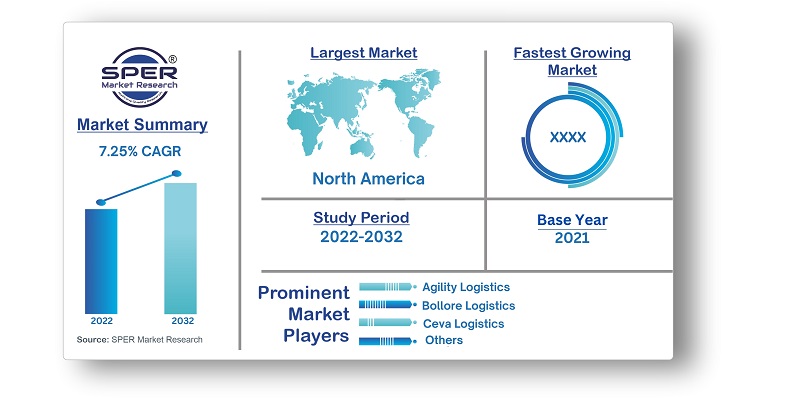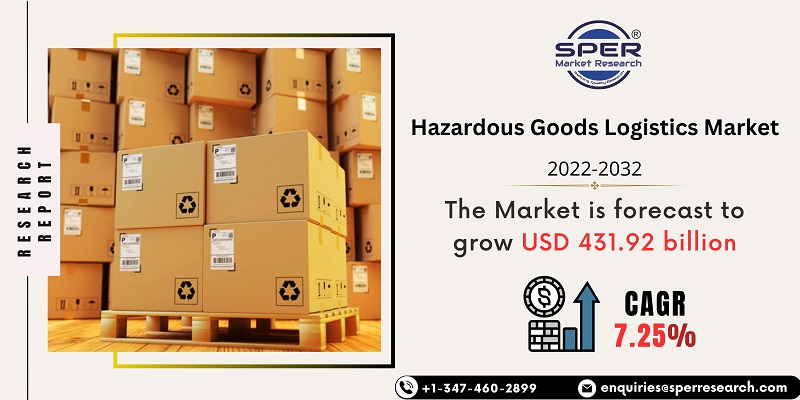
Hazardous Goods Logistics Market Growth, Size, Share, Revenue, Challenges and Future Trends 2032
Global Hazardous Goods Logistics Market Size- By Business Type, By Operation, By Product, By Application- Regional Outlook, Competitive Strategies and Segment Forecast to 2032
| Published: Mar-2023 | Report ID: AMIN2359 | Pages: 1 - 234 | Formats*: |
| Category : Automotive & Transportation | |||
- Rising Demand for Chemicals and drugs: As the world's population grows and disposable incomes rise, there is a greater demand for chemicals and drugs. As a result of this, the transportation and logistics of these hazardous items have expanded dramatically.
- Development of Industrial and Production Activities: Chemical production, oil and gas, and medicines are among the industries that are expanding globally. The demand for effective and dependable hazardous goods logistics services grows as these sectors deal with hazardous chemicals at various stages of their supply chains.


| Report Metric | Details |
| Market size available for years | 2019-2032 |
| Base year considered | 2021 |
| Forecast period | 2022-2032 |
| Segments covered | By Business Type, By Operation, By Product, By Application |
| Regions covered | Asia Pacific, Europe, Middle East and Africa, North America, Latin America |
| Companies Covered | Agility Logistics, Bollore Logistics, Ceva Logistics, DB Schenker, DGD Transport, DHL, DSV, GEODIS, Hellmann Worldwide Logistics, Kuehne + Nagel, Rhenus Logistics, Toll Group, United Parcel Service, XPO Logistics, Ych Group, YRC Worldwide Inc, Yusen Logistics |
- Chemical manufacturing
- Oil and gas Manufacturing
- Mining Industry
| By Business Type: |
|
| By Operation: |
|
| By Product: |
|
| By Application: |
|
- Global Hazardous Goods Logistics Market Size (FY’2022-FY’2032)
- Overview of Global Hazardous Goods Logistics Market
- Segmentation of Global Hazardous Goods Logistics Market By Business Type (Transportation, Warehousing, Value Added Services)
- Segmentation of Global Hazardous Goods Logistics Market By Operation (Seaways, Roadways, Railways, Airways, Storage and Services)
- Segmentation of Global Hazardous Goods Logistics Market By Product (Flammable, Explosive, Radioactive, Bio-Hazardous, Others)
- Segmentation of Global Hazardous Goods Logistics Market By Application (Industrial, Healthcare, Agriculture, Others)
- Statistical Snap of Global Hazardous Goods Logistics Market
- Expansion Analysis of Global Hazardous Goods Logistics Market
- Problems and Obstacles in Global Hazardous Goods Logistics Market
- Competitive Landscape in the Global Hazardous Goods Logistics Market
- Effects of COVID-19 and demonetization on Global Hazardous Goods Logistics Market
- Details on Current Investment in Global Hazardous Goods Logistics Market
- Competitive Landscape of Global Hazardous Goods Logistics Market
- Prominent Players in the Global Hazardous Goods Logistics Market
- SWOT Analysis of Global Hazardous Goods Logistics Market
- Global Hazardous Goods Logistics Market Future Outlook and Projections (FY’2022-FY’2032)
- Recommendations from Analyst
1.1. Scope of the report1.2. Market segment analysis
2.1 Research data source2.1.1 Secondary data2.1.2 Primary data2.1.3 SPER’s internal database2.1.4 Premium insight from KOL’s2.2 Market size estimation2.2.1 Top-down and Bottom-up approach2.3 Data triangulation
4.1. Driver, Restraint, Opportunity and Challenges analysis4.1.1 Drivers4.1.2 Restraints4.1.3 Opportunities4.1.4 Challenges4.2. COVID-19 Impacts of the Global Hazardous Goods Logistics Market
5.1. SWOT analysis5.1.1 Strengths5.1.2 Weaknesses5.1.3 Opportunities5.1.4 Threats5.2. PESTEL analysis5.2.1 Political landscape5.2.2 Economic landscape5.2.3 Social landscape5.2.4 Technological landscape5.2.5 Environmental landscape5.2.6 Legal landscape5.3. PORTER’S five forces analysis5.3.1 Bargaining power of suppliers5.3.2 Bargaining power of Buyers5.3.3 Threat of Substitute5.3.4 Threat of new entrant5.3.5 Competitive rivalry5.4. Heat map analysis
6.1 Global Hazardous Goods Logistics Market Manufacturing Base Distribution, Sales Area, Product Type6.2 Mergers & Acquisitions, Partnerships, Product Launch, and Collaboration in Global Hazardous Goods Logistics Market
7.1 Transportation7.2 Warehousing7.3 Value Added Services
8.1 Seaways8.2 Roadways8.3 Railways8.4 Airways8.5 Storage and Services
9.1 Flammable9.2 Explosive9.3 Radioactive9.4 Bio-hazardous9.5 Others
10.1 Industrial10.2 Healthcare10.3 Agriculture10.4 Others
11.1 Global Hazardous Goods Logistics Market and Market Share by Region (2019-2025)11.2 Global Hazardous Goods Logistics Market and Market Share by Region (2026-2032)11.3 Asia-Pacific11.3.1 Australia11.3.2 China11.3.3 India11.3.4 Japan11.3.5 South Korea11.3.6 Rest of Asia-Pacific11.4 Europe11.4.1 France11.4.2 Germany11.4.3 Italy11.4.4 Spain11.4.5 United Kingdom11.4.6 Rest of Europe11.5 Middle East and Africa11.5.1 Kingdom of Saudi Arabia11.5.2 United Arab Emirates11.5.3 Rest of Middle East & Africa11.6 North America11.6.1 Canada11.6.2 Mexico11.6.3 United States11.7 Latin America11.7.1 Argentina11.7.2 Brazil11.7.3 Rest of Latin America
12.1 Agility Logistics12.1.1 Company details12.1.2 Financial outlook12.1.3 Product summary12.1.4 Recent developments12.2 Bollore Logistics12.2.1 Company details12.2.2 Financial outlook12.2.3 Product summary12.2.4 Recent developments12.3 Ceva Logistics12.3.1 Company details12.3.2 Financial outlook12.3.3 Product summary12.3.4 Recent developments12.4 DB Schenker12.4.1 Company details12.4.2 Financial outlook12.4.3 Product summary12.4.4 Recent developments12.5 DGD Transport12.5.1 Company details12.5.2 Financial outlook12.5.3 Product summary12.5.4 Recent developments12.6 DHL12.6.1 Company details12.6.2 Financial outlook12.6.3 Product summary12.6.4 Recent developments12.7 DSV12.7.1 Company details12.7.2 Financial outlook12.7.3 Product summary12.7.4 Recent developments12.8 Geodis12.8.1 Company details12.8.2 Financial outlook12.8.3 Product summary12.8.4 Recent developments12.9 Hellman Worldwide Logistics12.9.1 Company details12.9.2 Financial outlook12.9.3 Product summary12.9.4 Recent developments12.10 Kuehne+Nagel12.10.1 Company details12.10.2 Financial outlook12.10.3 Product summary12.10.4 Recent development12.11 Rhenus Logistics12.11.1 Company details12.11.2 Financial outlook12.11.3 Product summary12.11.4 Recent developments12.12 Toll group12.12.1 Company details12.12.2 Financial outlook12.12.3 Product summary12.12.4 Recent developments12.13 United Parcel Service12.13.1 Company details12.13.2 Financial outlook12.13.3 Product summary12.13.4 Recent developments12.14 XPO Logistics12.14.1 Company details12.14.2 Financial outlook12.14.3 Product summary12.14.4 Recent developments12.15 Ych Group12.15.1 Company details12.15.2 Financial outlook12.15.3 Product summary12.15.4 Recent developments12.16 YRC Worldwide Inc12.16.1 Company details12.16.2 Financial outlook12.16.3 Product summary12.16.4 Recent developments12.17 Yusen Logistics12.17.1 Company details12.17.2 Financial outlook12.17.3 Product summary12.17.4 Recent developments
SPER Market Research’s methodology uses great emphasis on primary research to ensure that the market intelligence insights are up to date, reliable and accurate. Primary interviews are done with players involved in each phase of a supply chain to analyze the market forecasting. The secondary research method is used to help you fully understand how the future markets and the spending patterns look likes.
The report is based on in-depth qualitative and quantitative analysis of the Product Market. The quantitative analysis involves the application of various projection and sampling techniques. The qualitative analysis involves primary interviews, surveys, and vendor briefings. The data gathered as a result of these processes are validated through experts opinion. Our research methodology entails an ideal mixture of primary and secondary initiatives.



Frequently Asked Questions About This Report
PLACE AN ORDER
Year End Discount
Sample Report
Pre-Purchase Inquiry
NEED CUSTOMIZATION?
Request CustomizationCALL OR EMAIL US
100% Secure Payment






Related Reports
Our Global Clients
Our data-driven insights have influenced the strategy of 200+ reputed companies across the globe.




















